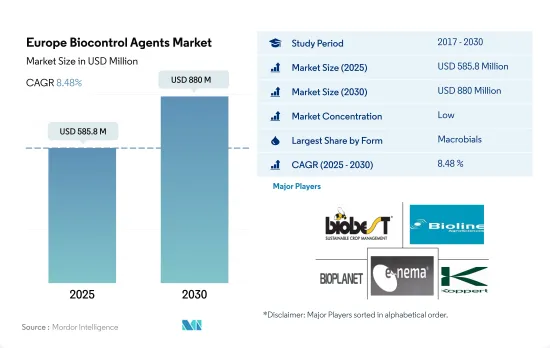Need help finding what you are looking for?
Contact Us
PUBLISHER: Mordor Intelligence | PRODUCT CODE: 1693758

PUBLISHER: Mordor Intelligence | PRODUCT CODE: 1693758
Europe Biocontrol Agents - Market Share Analysis, Industry Trends & Statistics, Growth Forecasts (2025 - 2030)
PUBLISHED:
PAGES: 188 Pages
DELIVERY TIME: 2-3 business days
SELECT AN OPTION
The Europe Biocontrol Agents Market size is estimated at 585.8 million USD in 2025, and is expected to reach 880 million USD by 2030, growing at a CAGR of 8.48% during the forecast period (2025-2030).

- Macrobial biocontrol agents dominate the market, with a value of about USD 458.8 million in 2022. Their dominance is mainly due to their ability to effectively control a wide range of pests without causing harm to the environment.
- Among macrobial biocontrol agents, predators dominate the market and are valued at USD 399.9 million in 2022. The predators' segment's dominance in the overall biocontrol agents market is due to their ability to attack different life stages of pests and even different pest species. They are voracious feeders compared to other biocontrol agents.
- Row crops dominate the macrobial biocontrol agents market, mainly due to their large cultivation area in the region. The consumption value of macrobial biocontrol agents in row crops is anticipated to reach USD 695.3 million by 2029.
- The market share of microbial biocontrol agents is limited compared to macrobial biocontrol agents due to various factors such as limited availability, less awareness about the utilization mechanism among farmers, and complex registration and commercialization processes.
- Bacterial biocontrol agents dominated the microbial market and accounted for about 89.0% of its value in 2022. Bacterial biocontrol agents are mainly dominant due to their ability to control various diseases and pests.
- However, integrated pest management programs promote the use of macrobial biocontrol agents such as predators and parasitoids. The European Commission promotes integrated pest management tools that can assist farmers and advisors, which may drive the macrobial biocontrol agents market value between 2023 and 2029.
- Microorganisms have become an increasingly popular alternative to chemical plant protection products, providing farmers with effective tools to control pests and diseases in their crops while reducing the environmental impact. The European biocontrol agents market witnessed steady growth in 2022 as four legal acts were endorsed by the Member States of the European Commission that simplify the approval and authorization process of microorganism-containing biological plant protection products. The objective is to provide farmers with effective tools to substitute chemical plant protection products and deliver on the objectives of the Farm-to-Fork Strategy.
- Russia currently occupies the largest share in the European biocontrol agents market, with a value share of 55.5% and a volume share of 21.2% in 2022. The increasing cultivation of horticultural crops and the discovery of new pests attacking crops are expected to drive further growth in the Russian market, with a projected CAGR of 8.3% between 2023 and 2029.
- Organic farming is a key industry of the EU agricultural sector, with nearly 330,000 organic farmers in the European Union in 2019, representing up to 20% of the farming area in the Member States. One of the targets of the Farm-to-Fork Strategy is to increase the total farmland under organic farming in the European Union, with plans for at least 25% of the EU's agricultural land to be under organic farming by 2030.
- The new regulations are expected to make it easier for EU organic farmers to access microorganisms used in biological plant protection products. This will provide them with new sustainable alternatives for controlling plant pests, contributing to a more environmentally friendly and sustainable approach to farming.
Europe Biocontrol Agents Market Trends
European green deal is majorly contributing for increasing organic cultivation across the region
Growing demand and rising the per capita spending on organic products in the region
Europe Biocontrol Agents Industry Overview
Additional Benefits:
Product Code: 500018
TABLE OF CONTENTS
1 EXECUTIVE SUMMARY & KEY FINDINGS
2 REPORT OFFERS
3 INTRODUCTION
- 3.1 Study Assumptions & Market Definition
- 3.2 Scope of the Study
- 3.3 Research Methodology
4 KEY INDUSTRY TRENDS
- 4.1 Area Under Organic Cultivation
- 4.2 Per Capita Spending On Organic Products
- 4.3 Regulatory Framework
5 MARKET SEGMENTATION (includes market size in Value in USD and Volume, Forecasts up to 2030 and analysis of growth prospects)
6 COMPETITIVE LANDSCAPE
7 KEY STRATEGIC QUESTIONS FOR AGRICULTURAL BIOLOGICALS CEOS
8 APPENDIX
Have a question?


SELECT AN OPTION
Have a question?


Questions? Please give us a call or visit the contact form.
